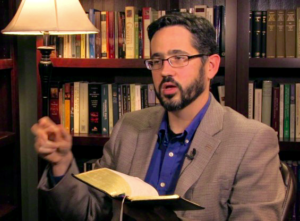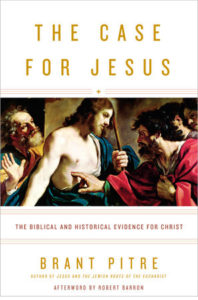Evangelization is about one thing: the person of Jesus Christ. Through Jesus we glimpse the Trinity; from Jesus comes the Church. The Bible begins as the story of a people awaiting salvation – a history of exodus unfolding in preparation for the Incarnation, the Messiah – and then about the rest of time as defined by revelation: Nativity, ministry, Crucifixion, Resurrection, Church: “I am the way and the truth and the life. No one comes to the Father except through me.” (John 14:16)
I sometimes buy audio-video courses on a lot of interesting subjects from a group called The Teaching Company. They call them the Great Courses and many are. I have not bought any of those offered on the New Testament, however, because the teacher is Bart D. Ehrman. I haven’t watched them, so I can’t speak to the qualities of Historical Jesus or Lost Christianities. And Dr. Ehrman may indeed be an excellent teacher. Still, I can’t bring myself to waste money and time listening to an atheist lecture about the Lord.
Ehrman’s latest book (and most recent video series), How Jesus Became God: The Exaltation of a Jewish Preacher from Galilee, argues that Jesus “neither thought of himself as God nor claimed to be God.”
That seems an odd thing to assert, given what we read in Scripture. And so Brant Pitre, author of one of the best books about Christianity in recent years, Jesus and the Jewish Roots of the Eucharist, has taken up the challenge laid down by Professor Ehrman and his ilk in a new book, The Case for Jesus: The Biblical and Historical Evidence for Christ.
Bishop Robert Barron, in an afterword to Pitre’s book, gives an excellent overview of its arguments:
Dr. Pitre has persuasively shown that the Gospels were written by either eyewitnesses (Matthew and John) or those in close association. . .(Mark and Luke), that they properly fit into the genre of ancient biography (and not folklore), that they were composed far earlier than the standard scholarly consensus has it, and that they are the results of a disciplined process of communication that commenced even during the earthly life of Jesus.
The Gospels and the Church are not legends passed down via an historical process akin to the parlor game of Telephone, in which each whispered version of the original message distorts it to the point that it’s barely recognizable at the end.
Most TCT readers are aware of the existence of various apocryphal “gospels” attributed to Peter, Thomas, Judas, and others. Professor Pitre gives them respectful treatment, but in judgment of them he defers, as in much else, to the early Church fathers Irenaeus, Eusebius, and Cyril. Those authorities are uniform in their opinion that all of those would-be “gospels” are pseudepigrapha, false writings. This is important, since many heresies are promoted in the pseudepigrapha, and because of the clear connection between those Fathers and the Apostles. Irenaeus, for example, was a student of Polycarp, who was a student of John. THE John.
The Case for Jesus deals succinctly and authoritatively with such matters as the dating and authorship of the Gospels, the messianic continuity between Old and New Testaments, and – most important in my view – the question of Christ’s identity, especially the Lord’s own testimony about it. Much of the book’s second half is devoted to exploring this essential matter, which is the heart of the Christian faith and a stumbling block for non-Christians.
The aforementioned Professor Ehrman says Jesus never claimed to be the Second Person of the Trinity. “Almost certainly,” he has written (“almost” seems awfully dodgy), “the divine self-claims in John are not historical.” But as Professor Pitre writes:
The only way to hold such a claim [that Christ never asserts His divinity in the Synoptic Gospels] is to completely ignore both the miracles of Jesus in which he acts as if he is the one God, as well as the sayings. . .in which he speaks as if he is the one God.
As we know the Lord repeatedly makes it clear to those blessed with eyes to see and ears to hear (see Matthew 13:16) exactly who He is. Pitre’s explication of the nuances of Hebrew and Greek are as good as it gets, and prove (to my satisfaction) the deficiencies of Ehrman-like revisionist scholarship.

Why, postmodern critics cry, did Jesus so often hide his alleged divine identity? If he was God, why not shout it from the rooftops? This sounds a lot like Satan tempting Jesus to throw Himself from the highest point of Herod’s Temple (actually, the critics are giving Him a push).
And it reveals a simple misreading of the whole of Scripture, which – from Genesis to Revelation – is the story of the unfolding of God’s Messianic plan for our salvation. But the plan’s fulfillment in the person of Christ was wholly unexpected in 1st-century Israel, and (pace René Girard) its proclamation was dangerous. Nobody, and this includes the Apostles right up to the Resurrection, could comprehend God as Man. Thus the parables, the signs and wonders. When the revelation came, death followed. Death and glory.
Those in the Ehrman camp are stuck on the horns of a trilemma. C.S. Lewis once wrote (Mere Christianity) that on the Biblical evidence one must chose among three options about Jesus (i.e. about His claims about Himself): he was lunatic, liar, or Lord. To this Pitre properly adds “legend,” but that’s just pushing the allegation of madness or deception onto the Apostles.
And the greatest case for Jesus as Lord is this: 2000-plus years on, 2.4-billion people alive today (and billions more before them) believe in the divinity of Jesus Christ.
















